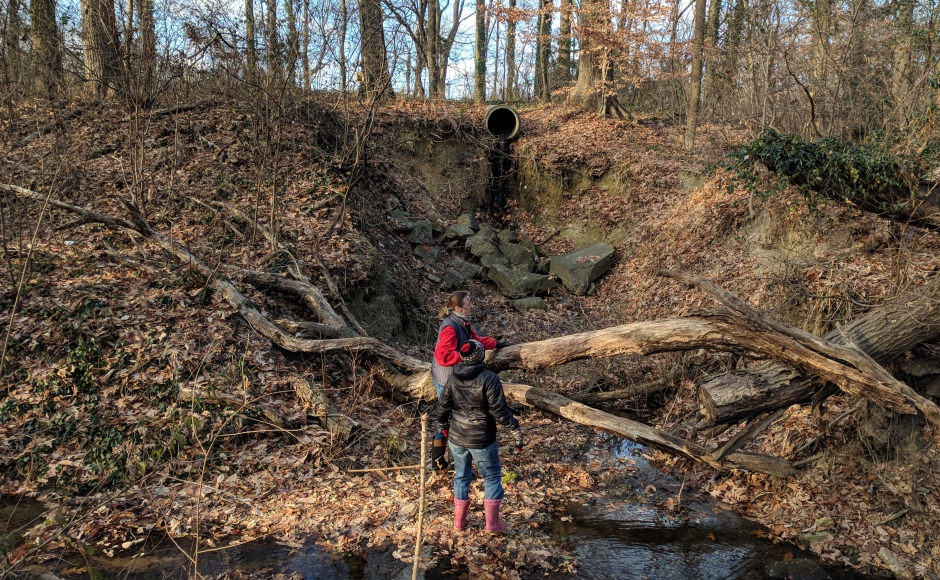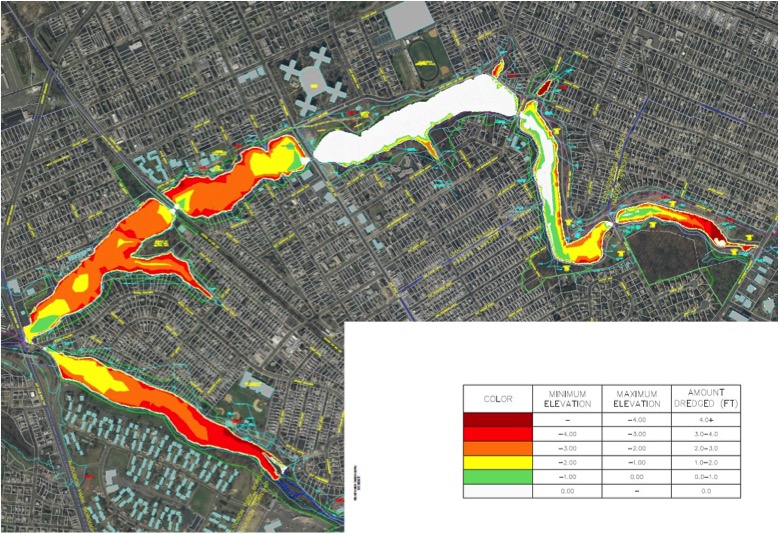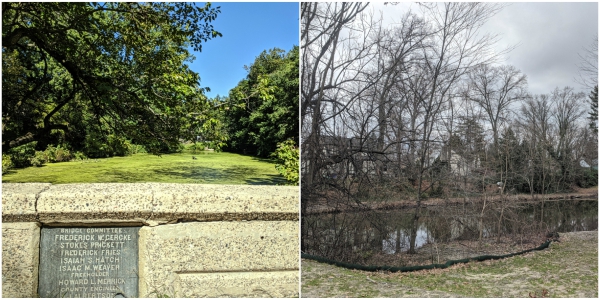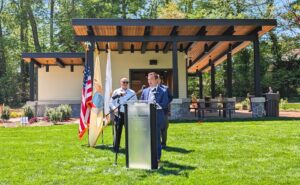In its second phase, the project will take on structural problems throughout the Newton Creek watershed, including in Saddler’s Woods, Peters Creek, and Newton Lake Park.
By Sarah Baldwin | March 23, 2021
With the initial phase of the $20-million Newton Creek waterway dredging project having concluded at the end of 2020, Camden County government officials have begun planning the scope of work to be done in 2021.
Work during this next phase will center on stream restoration in portions of Saddler’s Woods in Newton Lake Park, in Peters Creek in Oaklyn, as well as in sections of Saddler’s Woods along MacArthur Boulevard in Haddon Township.
Although the county has jurisdiction over most of the creek shoreline and over Peters Creek, some portions of the project touch privately owned land.
When the stream restoration work begins, the county government will work with property owners along the waterway banks “to give recommendations to homeowners [on how to manage their shorelines],” said Camden County Parks Director Maggie McCann Johns. The county is also seeking ways to alleviate any financial burdens that may be placed on homeowners affected by the project.
“The hope is to equip homeowners with small grants that they would be able to use to do some of this work on their properties, and be able to supplement or offset the costs,” McCann Johns said.
“We’re trying to find creative solutions to all of these issues, and that includes any shoreline that isn’t owned by the Parks Department,” she said.
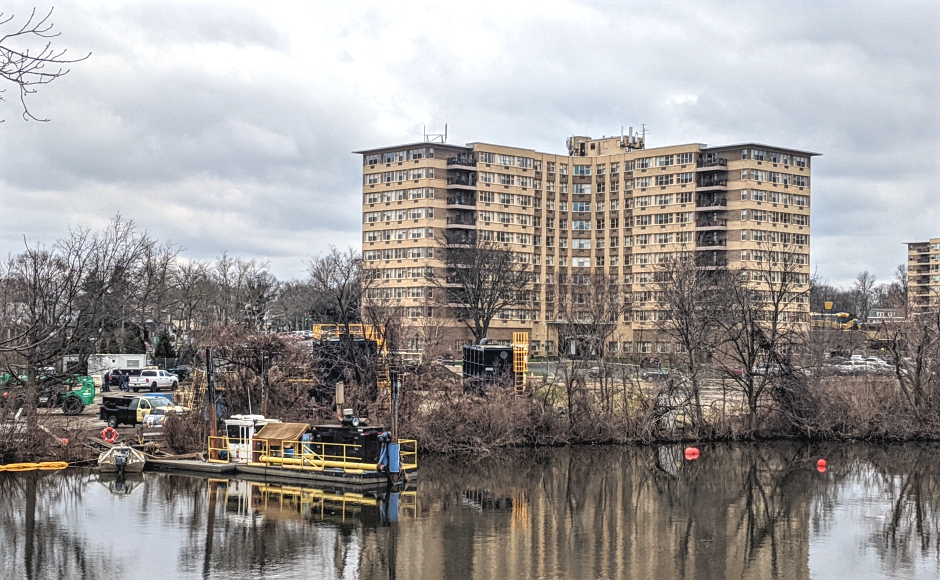
Newton Creek Dredge Dewatering site at the White Horse Pike in Collingswood – 1-5-21. Credit: Matt Skoufalos.
The county also will manage directly the stormwater infrastructure work to be done on several large properties within the restoration area, including Saddler’s Woods, which is owned by the Haddon Township municipal government, and land bordering it, which is owned by the Haddon Township School District.
Other large, privately owned properties within the scope of the project include Paul VI Catholic High School, which is owned by the Roman Catholic Diocese of Camden, and the Haddonview Apartments, which is owned by Legow Management Company of Livingston.
McCann Johns said the county will take responsibility for work done at those sites as well, reasoning that its management of the work required on these larger properties will advance the project more efficiently than trying to synchronize it across multiple ownership groups.
“While we know that these are properties owned by entities other than the county, we are taking on the onus, and taking this as our responsibility to do this work,” she said.
“At the end of the day, it’s one watershed.
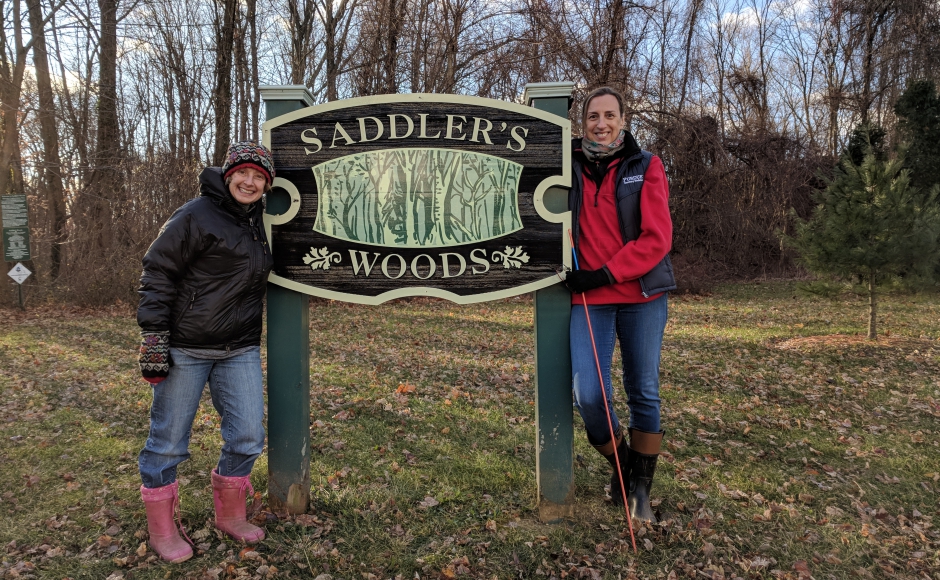
Newton Creek Watershed Association members Lorraine Prince (right) and Janet Goehner-Jacobs in Saddler’s Woods, 2018. Credit: Matt Skoufalos.
Girding against a 100-year flood
The headwaters of Newton Creek originate in streams like Saddler’s Run, which is located in Saddler’s Woods, and which borders the Paul VI campus.
In 2018, Saddler’s Woods Conservation Association (SWCA) and Newton Creek Watershed Association (NCWA) criticized the diocese for failing to respond to their requests to mitigate the impact of stormwater outflow from the Paul VI property, which they said was the single biggest upstream source of sediment deposit into the lake.
The groups blamed the school’s athletic fields and massive, paved parking lot—both of which drain directly into an outfall in the protected woodlands—for carrying away soil from the natural stream bed there, and depositing it into Newton Creek. Their argument seems to have been borne out by the scope of the second phase of the project.
“Before we started designing the work that’s being done on the areas owned by the diocese, Haddon Township, and the [Haddonview] apartment complex, we had the engineers look at the areas that contribute the most to sedimentation within the lake,” McCann Johns said.
“Those were the areas—and also areas within Peters Creek—that we found that were contributing the most sediment,” she said.
Without redesigning the entire stream in Saddler’s Woods, dredge managers Johnson, Mirmiran & Thompson (JMT) Engineering will design a stormwater managing system equipped to handle 100-year floods there—extreme weather events with a 1-percent chance of occurring in any given year.
The stormwater management system will consider areas that most contribute to sediment deposits into the waterway, as well as accounting for stormwater outfalls that enter the system through Saddler’s Woods.
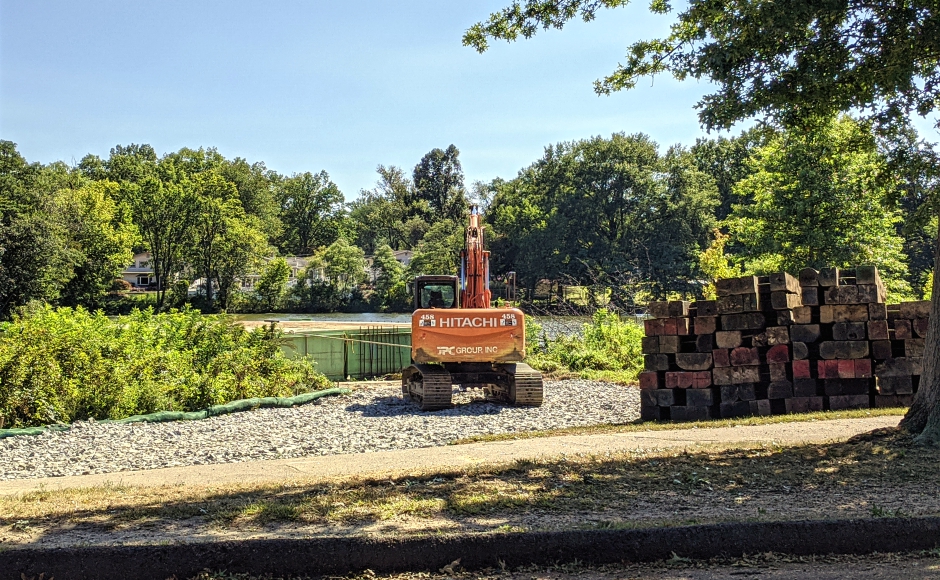
Dredging equipment on the shores of Newton Creek in Newton Lake Park, Haddon Township. Credit: Matt Skoufalos.
NWCA and SWCA, which closely monitored Phase One of the project, will be working alongside the county during Phase Two as well.
Lorraine Prince, SWCA Education and Community Outreach Coordinator, said she’d like the county to develop an effective mitigation strategy to counteract weather emergencies less severe than the 100-year floods.
During the 2020 dredge, a storm overflowed the banks of Nichols Pond, felling a nearly 100-year-old oak tree in Collingswood. Prince wants the county plan to account for the possibility of similar occurrences.
“The way they treated the falling of that big tree because of the flooding, to us, is an indication of the fact that they need to be more careful,” she said.
In December 2020, the county finished the first portion of the project, which included dredging and restoring two bodies of water—“Pond Number Two,” situated at the intersection of Bettlewood Avenue and North Newton Lake Drive in Collingswood, and nearby Nichols Pond—and initial dredging in a third section of the waterway between Bettlewood and the White Horse Pike.
Crews also removed In-water vegetation in three sections between Cuthbert Boulevard and Lees Lane—between Lees Lane and Bettlewood Avenue; and between Bettlewood Avenue and the White Horse Pike—as well as taking down multiple, disconnected headwalls from the latter two sections.
New Jersey Department of Environmental Protection (NJDEP) permitting regulations only allow dredging to occur for six months consecutively, so the dredging that was paused in December 2020 will resume in July 2021.
As the county is still amid Phase Two of its environmental planning process with NJDEP, McCann Johns isn’t sure of the exact timeline for the streambank restoration and stormwater management work to begin.
“We’ve been hoping that, in the next few months, we can actually get into the permitting process, and we also need to have a public meeting surrounding it [before beginning the next phase],” she said.

